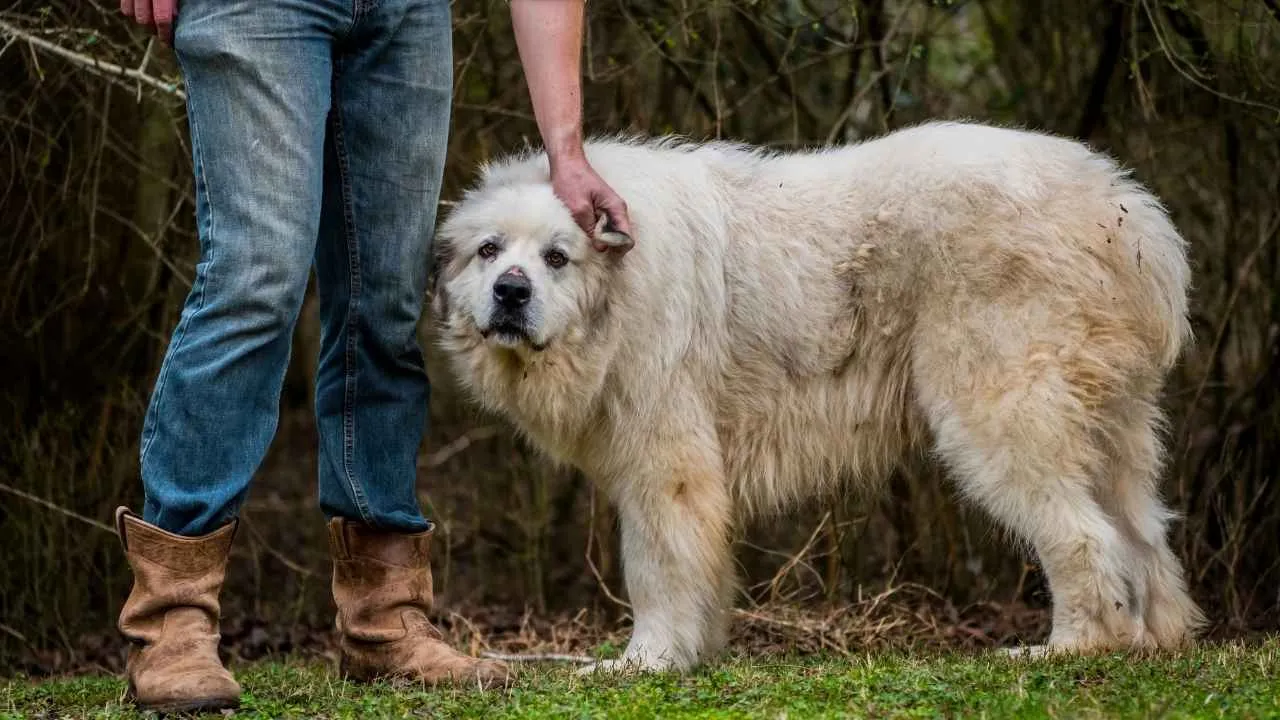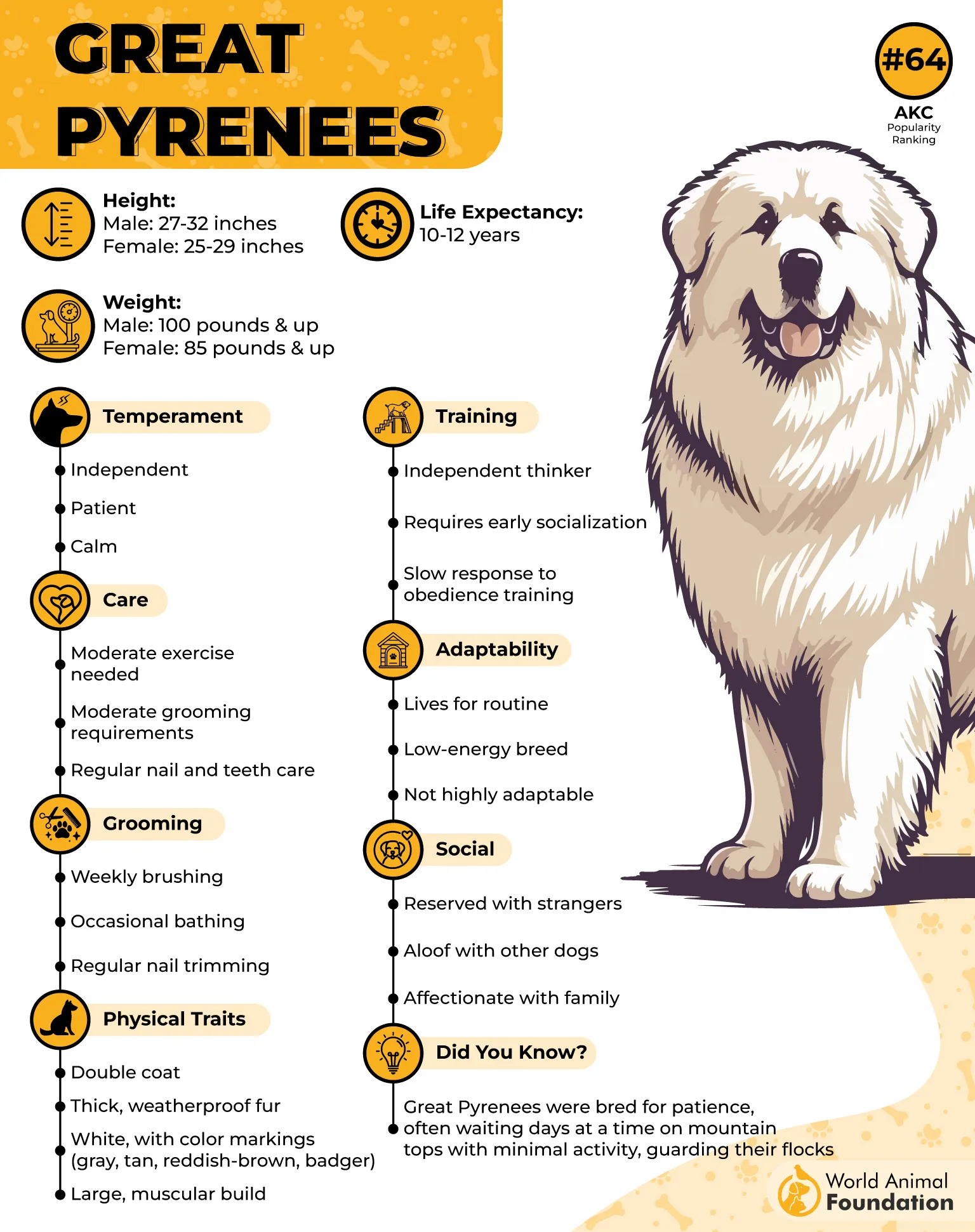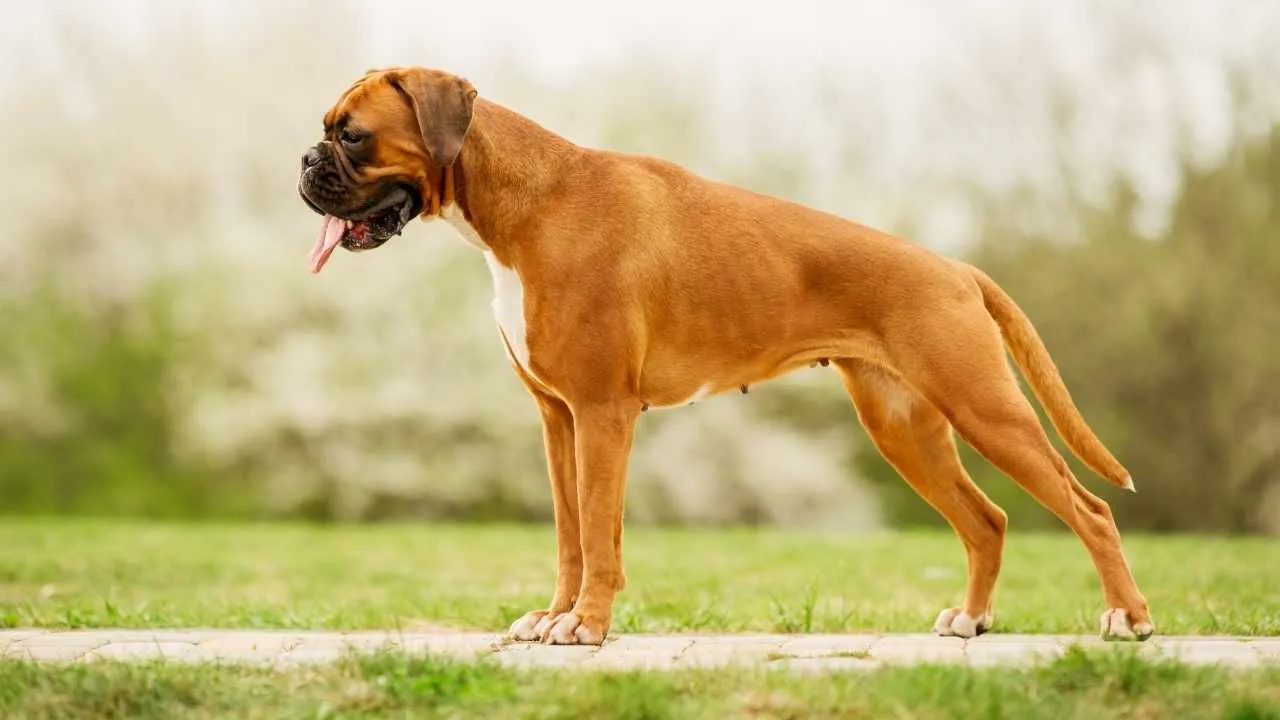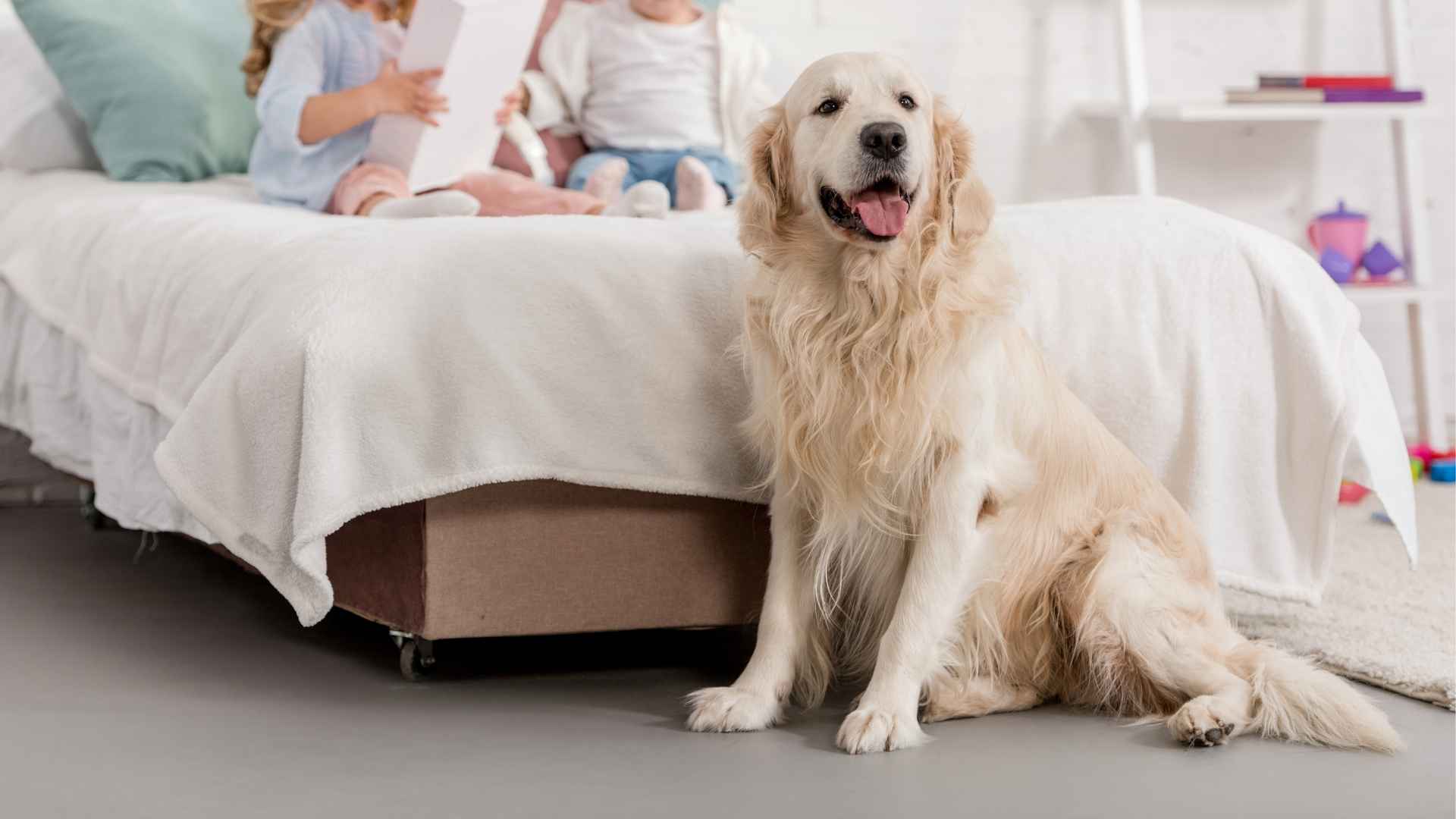The lights are out, the bedtime story is over, and your child is tucked in under their favorite blanket. But outside the door, the house creaks. Shadows shift. Somewhere in the night, a leaf hits the window.
In that silence, one presence never wavers, the dog curled tightly at the foot of the bed. Their eyes flicker toward every sound, their body still but ready.
It’s the kind of comfort you can’t train or buy. Some dogs instinctively choose to guard their favorite humans, especially when those humans are small, soft-spoken, and fast asleep. They watch. They stay. They guard.
In this article, we’ll meet the breeds that make nighttime feel safer. These dogs protect, silently and faithfully, through every hour of the night.
Dog Breeds That Guard Kids’ Beds Every Night
1. Great Pyrenees

The Great Pyrenees is known for staying alert through the night, often sleeping near doorways or beside the bed without needing to be told. They’ve been bred for centuries to work overnight shifts in solitude, making them naturally inclined to protect while others sleep.
Instincts Built for Nighttime Vigilance
Originally bred to guard livestock from wolves and bears, this breed has an innate ability to sense movement or unusual sounds, as highlighted by WebMD. Their powerful bark is used sparingly, but always with purpose. Even subtle cues from inside the house are enough to keep them on high alert while remaining composed.

Protective Without Being Aggressive
The Great Pyrenees is deeply loyal but not reactive without cause. They don’t startle easily and show impressive judgment, especially around children and unfamiliar guests. With proper training, they learn to manage their natural guarding instincts in a balanced and reassuring way.
Confident Around Family and Pets
They accept the home as their territory, treating every room as part of their job. Though independent, they tend to be gentle with kids and can coexist well with other dogs if introduced early. They do their work quietly, never competing for attention but always staying near.
2. Boxer

Boxers are naturally attentive to sounds, movement, and sudden changes in their space, especially when kids are nearby. Their alert stance and upright ears make them appear playful during the day, but highly aware during the quiet hours. They instinctively check doors and corners before settling down.
Nighttime Routine with a Purpose
It’s common for Boxers to choose sleeping spots that give them a clear view of the child’s bed. They often respond to even the softest stir or sound from the room. This predictable routine becomes their self-assigned night shift, one they commit to without hesitation.

Muscle Paired with Judgement
They are one of the excellent guard dog breeds known for balancing strength with emotional awareness. When properly trained, they develop clear boundaries between vigilance and aggression. Their confidence grows stronger when they feel they’re protecting a smaller, more vulnerable family member.
Protective but Emotionally Tuned In
Boxers fall under the group of naturally protective dogs that also thrive on connection and structure. They pick up quickly on household dynamics and adjust their behavior to match. Whether resting near the bed or quietly pacing the hallway, their loyalty remains steady and focused.
3. Rottweiler

Rottweilers often choose sleeping spots near doorways, hallways, or their owner’s room without needing instruction. They monitor movement throughout the night, showing quiet confidence while staying close enough to respond if something feels off.
Strong Awareness Without Overreacting
Known for excellent judgment, Rottweilers do not jump at every sound. They observe before acting, which makes them ideal for homes with children. Their calm alertness at night is grounded in deep-rooted protective instincts that make families feel secure without creating noise or stress.

Guarding With Loyalty and Control
What makes them great guard dogs is their balance between power and control. They can remain still for hours but are quick to step in when they sense a true threat. With consistent training, their behavior can be shaped to suit home routines and child-friendly environments.
Protective but Socially Grounded
They form tight bonds with the people they live with, particularly children, as per the American Rottweiler Club. When raised around other pets, they often coexist smoothly and learn household boundaries early. Their focus always remains on safety, often resting in spots where they can quietly monitor without needing direction.
4. Doberman Pinscher
Dobermans are hardwired to notice every shift in their environment, making them extremely aware of changes even during the quiet hours of the night. Their natural drive to defend the household activates most strongly when their family is asleep.
Strategic, Not Reactive
Their guarding behavior is based on evaluation, not impulse. Dobermans tend to position themselves where they can observe movement and react quickly if needed. Their intelligent watchfulness prevents overreactions, and they remain calm unless there’s a real reason to act.
Bonded Through Routine and Loyalty
This breed forms strong attachments through consistency and shared routines. When placed in a family setting, they quickly develop a pattern of nightly supervision. Being incredibly loyal, they consider watching over the children part of their role, not something that needs to be taught.
Respected by Working Professionals
Dobermans have long been trusted by the military and the police force for their ability to combine focus with measured action. In a family, those same instincts are redirected toward home safety. When raised with proper structure, they behave like a well-trained bodyguard dog.
5. Bullmastiff
Originally bred to guard large estates, Bullmastiffs have a natural pull toward protective roles in the home. They often rest near bedroom doors or kids’ beds, quietly scanning their space. Even when still, they stay mentally alert throughout the night without needing prompts.
Alert Without Causing Alarm
Their protective sense doesn’t rely on noise but on observation and calm response. They shift their position often and react subtly to sounds or foot traffic. That quiet presence becomes a layer of unseen safety while the house sleeps.
Gentle Strength That Needs Shaping
Bullmastiffs are powerful but stable dogs, making early guidance essential for home life. Through proper training and socialization, they become responsive guardians without tension. Their sense of duty is shaped by consistency, not constant correction.
Low Chaos, High Awareness
This breed doesn’t operate on high energy levels but still covers its space with quiet purpose. Their natural instinct to protect shows through their still posture and sharp awareness. Even when lying down, they remain tuned in to the room’s energy.
6. Great Dane
Despite their size, Great Danes have a soft spot for staying close to their favorite people at night. Many naturally settle beside beds, often stretching across the floor like a protective barrier. Their steady breathing and solid presence can make kids feel more secure during sleep.
Instinctively Calm Yet Highly Alert
This breed is observant without being restless. They are alert to movement, shadows, or sounds that break the nighttime quiet, and often react with a low, purposeful bark. Their instincts are balanced enough to differentiate between threats and ordinary household activity.
Needs That Support Routine
Great Danes have relatively low grooming needs and enjoy simple nighttime routines, as PDSA claims. While they do benefit from early socialization and proper boundaries, their calm nature makes them ideal for families with small children. They take direction well and tend to respect household quiet hours.
Emotional Bonding and Mental Ease
While they need moderate exercise during the day, Great Danes are also content with relaxed bonding moments in the evening. Light play, soothing voices, and closeness are often enough mental stimulation for them to wind down. Their emotional stability shines when it’s time for lights out.
7. German Shepherd
German Shepherds tend to position themselves between doorways or at the edge of beds when a child sleeps. They are naturally alert and aware of their surroundings, making them dependable even during the quietest hours. Their presence brings a steady, watchful calm to nighttime routines.
Strong Instincts with a Gentle Core
This breed has been used for protection work for over a century, and those instincts carry into home life with children. They remain calm unless truly needed and are known to assess situations before acting. That balance makes them reliable guardians in family environments.
Trainable Minds, Focused Loyalty
Known as one of the most highly trainable breeds, they quickly adapt to nighttime routines and house rules. Their sharp memory and focus allow them to respond to subtle cues. With consistency, they understand boundaries without needing constant correction.
Emotional Connection with the Family
They form deep bonds, often attaching themselves to the person they feel most responsible for. Around kids, they tend to be naturally affectionate while staying protective. Their highly intelligent nature helps them recognize tone and behavior, which builds mutual trust quickly.
8. Cane Corso
Did You Know: The Cane Corso’s name comes from the Latin “cohors,” meaning “guardian” or “protector,” reflecting its historic role in guarding farms and Roman estates.
Cane Corsos are naturally territorial and tend to form intense bonds with household members, especially children. Their quiet but observant nature allows them to monitor a room without pacing or fussing. Once they choose a spot, they stay fixed and focused through the night.
Confidence That Fills a Room
This breed has a posture that speaks for itself — upright, alert, and fully aware of the surroundings. They pick up on movement instantly, from a creaking door to soft footsteps, and adjust their stance without making a scene. Their size alone deters uninvited activity.
Sensitivity to Household Patterns
Corsos are deeply in tune with their environment, often memorizing routines and reacting to anything out of place. They will often lie close to a child’s bed, especially after noticing where the family naturally gathers at night. This loyalty builds over daily observation.
Protective Without Constant Noise
Cane Corsos do not rely on barking to show their presence, which makes them particularly effective during nighttime. Their guarding style is based on controlled presence and timing. With consistent leadership, they stay balanced and attentive without becoming reactive.
9. Rhodesian Ridgeback
Rhodesian Ridgebacks are known for being physically imposing yet emotionally restrained. They tend to keep watch from a short distance, staying quietly observant throughout the night. Their silent companionship often provides a sense of safety without needing constant interaction.
Instinctive Guardians with Measured Reactions
Historically developed to track and corner lions, they inherited the ability to assess threats calmly before reacting. This measured response translates well to household life, especially around sleeping children. They don’t bark often, but they remain deeply aware of their surroundings.
Bonded to Their Inner Circle
While not openly needy, Ridgebacks are strongly connected to their families. They often pick a favorite spot near the child’s room and return to it out of habit and loyalty. Their protective nature intensifies indoors, where they quietly monitor movement at night.
Low Maintenance but Deeply Loyal
This breed requires space and activity during the day but settles down into a relaxed state once indoors. When raised with proper routines, they naturally become nighttime sentinels. Their calm demeanor makes them a quiet but consistent presence near beds or bedroom doors.
10. Anatolian Shepherd
Bred for centuries in the rugged terrain of Turkey, the Anatolian Shepherd has unmatched instincts when it comes to territory and nighttime protection. They are drawn to elevated or entry-point areas, often positioning themselves where they can observe without being disturbed.
Quiet Strength That Reassures
This breed watches silently, staying aware of every shift in the environment. They don’t bark unnecessarily, but any unfamiliar sound or scent is enough to trigger their controlled presence. Their quiet alertness helps children feel safe, especially during nighttime hours when the home is still.
Protective Without Losing Composure
The Anatolian Shepherd is known for its self-control in tense situations. With proper socialization and consistent routines, they adapt well to homes and families. Their protectiveness is never chaotic — it’s deliberate, measured, and grounded in a deep-rooted sense of responsibility.
Independent Yet Family-Oriented
Though highly independent, they still form strong bonds with the people they live with. This loyalty is expressed through proximity, often by staying close to sleeping children or resting in doorways. It’s no surprise they’re often listed among the best guard dogs across working breeds.
Conclusion
Some dogs play fetch. Others keep watch. These gentle giants do both—but when night falls, their focus shifts. They become still, alert, and loyal in a way words can’t quite explain.
Whether it’s a playful puppy growing into a protector or a calm rescue learning the rhythms of your home, these breeds show what it means to guard without noise. Many of them are natural guard dogs, but they also become something else: a trusted canine.
If your home is ready for that quiet strength, any of these breeds would be an excellent addition. They don’t just sleep beside your children. They stay. They protect. They care.


